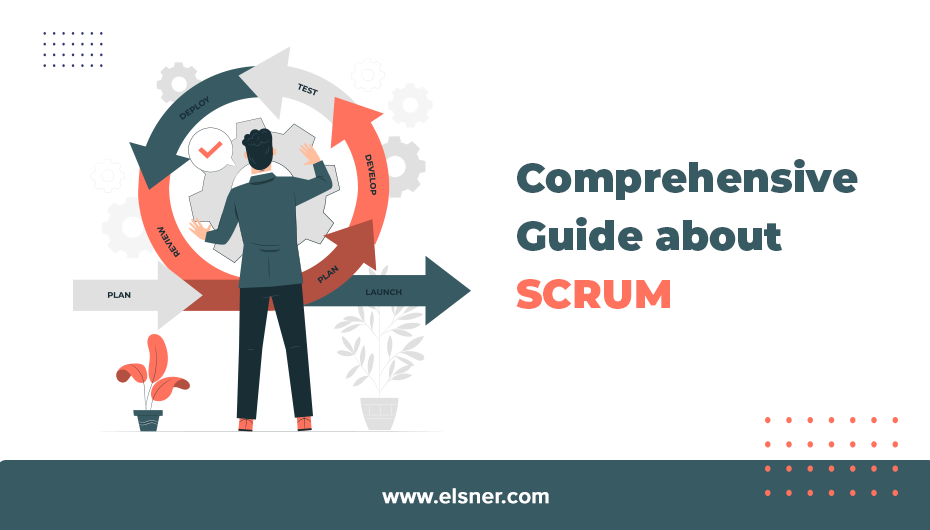What is Scrum?
Scrum is a system for creating programming items. It’s intended to be adaptable and permits you to work in a quick-moving climate with continuous changes while conveying top-notch results.
The Scrum Framework

[Image Source: https://shorturl.at/ktEJ4]
The Scrum system is the name for a collaborative advancement process, which gives a decent arrangement of rules to assist programming designers with building their projects. This guarantees that you don’t run into issues during the improvement phase of your item.
The general thought is that you give standard updates and criticism to partners (individuals keen on how your undertaking is going). Similarly, they can provide criticism and ideas to keep things on target. The Scrum cycle includes separating the undertaking into little advances, with everyone giving important data about what works and what doesn’t. By consistently checking with partners, groups can change and refresh their arrangements as essential before continuing work on the subsequent stage.
The Scrum Values
Much of the time, coordinated programming improvement is an exceptionally unusual and unpredictable interaction, so it requires shrewd individuals and the capacity to acknowledge the change. Scrum remembers five sections that are general qualities for coordinated designing:
– Item concentration and fulfillment of client wants (idealness)
– Consistent criticism from clients drew in staff (ceaseless improvement)
– Coordinating work from various foundations into an effective group work process with altruism toward outcasts.
– Versatility, imagination, and fresh reasoning are supported, no matter the set of experiences or training level (advancement).
– Vulnerability is a positive. Continuously advance toward vulnerability.
The Scrum Team
The Scrum values adjust well to the present world and comprehend how to assemble groups currently. Notwithstanding this arrangement, it may be challenging for associations attempting to adopt agile designing practices. That is why many organizations add a little group or person who helps guide possible impacts and offers a viewpoint on shifts in authoritative culture that might require a change end route. There are three significant jobs in a scrum group. We should find out about them.
The scrum item proprietor
The group’s scrum item proprietor is a solitary individual who, in addition to other things, keeps up with the item excess, focusing on work and apportioning assignments inside the run, utilizing speed to keep themselves informed. This job prompts enhanced efficiency while lifting moral obligation in melding projects.
The Scrum Master
Frequently, the job of a scrum ace is given to somebody inside one specific division. This individual has a significant impact in assisting everybody with gaining great headway during their undertaking by planning working propensities, zeroing in on viability instead of effectiveness or speed.
Likewise, their obligation as group mentors guarantees a good outcome for each phase of creation by regulating the smooth running of exercises, which can assist with making preparations for expected disturbances in timetable and waste. Groups influence something beyond their cycle because a scrum ace is centred on how agile designing practices cooperate with others to change the board strategies for the most extreme outcomes.
The scrum advancement group
Similarly, the advancement group comprises a cross-segment of individuals that assist with examination and investigation, including originators, designers, item administrators, or quality specialists. It could likewise remember partners working on projects, including human relations or promoting items for general delivery to serve client needs best.
Organizations genuinely should have a person who helps guide these progressions since they may not be ready to take on it without preparation.
Scrum Artefacts
Regarding nimble programming improvement, Scrum is a structure for overseeing projects. It was initially utilized in item advancement; however, it has since been adjusted to work with different fields.
The three fundamental ancient rarities are:
- Item Backlog: The rundown of all thoughts that should be created or assembled.
- Run Backlog: A focused rundown of undertakings that will be chipped away during a run and an arrangement for finishing them toward the finish of the run time frame.
- Run Burndown: A plan for the Daily Stand-up that incorporates what has been finished, hindrances to advance and impending errands.
The three antiques are utilized to follow item advancement from starting until the end so that work can be estimated by how well it is advancing and constant input circles and upgrades after some time.
Scrum Events
The Sprint fills in as a centre point for any remaining exercises. Scrum gives an organized opportunity to look at and adjust Scrum objects on every occasion. These social events are explicitly coordinated to provide important straightforwardness. Any experience that isn’t worked by the guidelines will bring about botched chances to check and adjust. Scrum utilizes occasions to create consistency and diminish the necessity for gatherings that aren’t essential for the Scrum structure.
All occasions ought to be held simultaneously and area to work on intricacy.
The Sprint
The run is a period box where changes to the product are planned and created. Cycles consider customary advancement of this interaction by giving robotized designated spots that further develop versatility and information exactness. To finish working items, emphases will be dispersed across weeks or months, relying upon when it falls as indicated by business requests — even only one out of every odd week for certain choices, for example, subsets of weeks being incorporated at every occasion to decrease upward expenses.
Run Planning
The run arranging meeting allows everybody in the association to feature and comprehend what their jobs are during that time-box. During this gathering, engineers will share refreshes about the current item before allotting assignments for those days, remembering the extent of work required by every individual to finish it effectively regardless of how restricted or broadened.
The members check whether anybody needs to broaden or be part of these ongoing undertakings because of the individual conditions of the individuals from the group.
The Sprint Retrospective
After each run, review gatherings are held to acquire input on what worked out positively and what could be refined during that time-box. This considers arranging changes likewise founded on past exercises, such as giving more contribution to explicit assignments or adjusting how they will be finished to avoid any redundancy, indicating a profoundly responsive turn of events.
After exploring everything from unmistakable things like finished stories to subjective input on feeling great as an individual and group, the ideal way forward is chosen. This likewise considers upgrades before the following run through potential changes like adding more people or changing which assignments need to be finished.
The Sprint Review
Whenever all that has been scheduled in this gathering with potential changes being made during these gatherings, the last meeting will be held to survey everything that was accomplished during those weeks and think of item objectives — what requirements have been done before the next run, what delivery ought to be prepared and so forth.
These gatherings happen all through the venture simultaneously to ensure no significant undertakings are missed while likewise making progress toward numerous objectives as a main priority. Through these Sprints and reviews — meeting after everyone — we foster ourselves to level up those functional skills through a ceaseless criticism circle with ourselves on top of this further developing item improvement for all.
Everyday Scrum
During the Daily Stand-up gathering, all colleagues talk about what they had the option to finish during the previous day and what detours might have happened, which eventually can be anticipated or forestalled.
At the Daily Stand-ups, examine and conclude what requirements are changing; however, don’t take excessive time. It ought not to belong; it ought to be short, compact and forthright. In some cases, you want more point-by-point conversations with individual colleagues or others associated with the undertaking, so it is helpful to have another gathering, on the other hand, either previously or after the stand-up. To abbreviate stand-ups and make them more organized, a valuable way is to record any progressions a short time later, assuming another interaction is being presented; individuals find it simpler to recollect things when they are got on paper.




